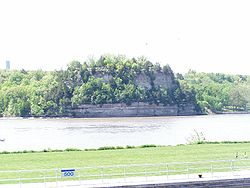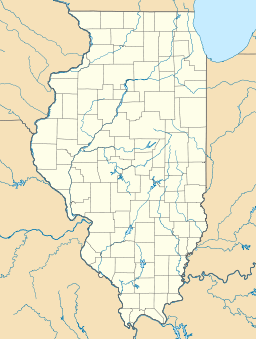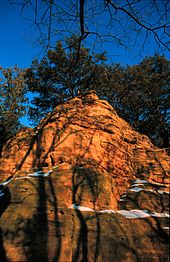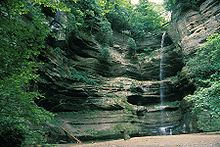- Starved Rock State Park
-
Starved Rock State Park Illinois State Park Starved Rock as viewed from the north side of the Illinois River.Named for: Starved Rock Country United States State Illinois County LaSalle Count Township Deer Park Location LaSalle County, Illinois, USA - coordinates 41°19′17″N 88°59′25″W / 41.32139°N 88.99028°W Area 2,630 acres (1,064 ha) Founded 1911 Management Illinois Department of Natural Resources Visitation 2.1 million [1] Website: Starved Rock State Park Starved Rock State Park is a state park in Illinois, characterized by the many canyons within its 2360 acres. Located just southwest of the village of North Utica, in Deer Park Township, LaSalle County, Illinois, along the south bank of the Illinois River, the park hosts over two million visitors annually.[1]
In the pre-Columbian era, the area was home to Native Americans, particularly the Kaskaskia who lived in the Grand Village of the Illinois across the river. Louis Jolliet and Jacques Marquette were the first Europeans recorded as exploring the region, and by 1683, the French had established Fort St. Louis on a large sandstone butte overlooking the river. According to a native legend, a group of Illinois Confederation (Illini) pursued by the Ottawa and Potawatomi fled to the butte in the late 18th century. The Ottawa and Potawatomi besieged the butte until all of the Illini had starved, and the butte became known as Starved Rock. The butte area was designated a U.S. National Historic Landmark in 1960.
Contents
Geology
A catastrophic flood known as the Kankakee Torrent,[2] which took place somewhere between 14,000[3] and 17,000 years ago,[4] before humans occupied the area, helped create the park's signature geology and features, which are very unusual for the central plains.
History
Early settlements
This area has been inhabited by humans since 8000 BC. Archeological surveys have located Archaic period (8000 – 2000 BC) settlements along the Illinois River. These prehistoric indigenous peoples thrived by hunting for waterfowl and deer with spears; copper Clovis points from these spears have been unearthed in the park.[5] Havana Hopewell settlers during the Woodland period (1000 BC – 1000 AD) built earthwork mounds. They also made crude pottery and domesticated plants.
The growth of agriculture and maize surpluses supported the development of the complex Mississippian culture. Its peoples established permanent settlements in the Mississippi, Illinois, and Ohio river valleys. They harvested maize, beans, and pumpkins, and were noted for their copper ornaments. The first interaction with other tribes occurred during this period: artifacts from the major regional chiefdom and urban complex of Cahokia, at present-day Collinsville, Illinois, have been recovered at Illinois River sites.[5]
The earliest group of inhabitants recorded at the region were the historical Kaskaskia, whose large settlement on the north side of the Illinois River was known as the Grand Village of the Illinois. The Kaskaskia were members of the Illinois Confederation (Illini), who inhabited the region in the 16th through the 18th centuries. They lived in wigwams made of light-weight material. The natives could easily dismantle these structures when they traveled to hunt bison twice a year. The women gathered tubers from nearby swamps as a secondary source of food. Small bands of aggressive Iroquois settlers arrived in northern Illinois in 1660 in search of new hunting grounds for beaver, stimulating inter-tribal warfare. The Kaskaskia struggled with the Iroquois, who were armed with guns seized from or traded by Europeans in the eastern United States.[5]
In 1673 Louis Jolliet and Father Jacques Marquette were the first Europeans to explore the northern portion of the Mississippi River. On their return, they navigated the Illinois River, which they found to be a convenient route to Lake Michigan. Along the river, they found seventy-three cabins in the Grand Village, whose population rapidly expanded in the next several years. Marquette returned to the village in 1675 to set up the Mission of the Immaculate Conception, the first Christian mission in modern-day Illinois. Marquette was joined by fellow Jesuit priest Claude-Jean Allouez in 1677. By 1680, the Grand Village was home to several hundred native cabins and a population of 6,000-9,000.
In 1680 the Iroquois temporarily drove the Kaskaskia out of the settlement during the Beaver Wars, as they were trying to expand their hunting territory. With an increase in French settlers in the area, the Kaskaskia returned by 1683. The French were able to provide the Kaskaskia with guns in exchange for other goods, which they used for defense against the powerful Iroquois, already armed by the English.
French explorers led by René-Robert Cavelier, Sieur de La Salle built Fort St. Louis on a large butte by the river in the winter of 1682.[6] Called La Rocher, the butte provided an advantageous position for the fort above the Illinois River.[6] A wooden palisade was the only form of defenses that La Salle used in securing the site. Inside the fort were a few wooden houses and native shelters. The French intended St. Louis to be the first of several forts to defend against English incursions and keep their settlements confined to the East Coast. Accompanying the French to the region were allied members of several native tribes from eastern areas, who integrated with the Kaskaskia: the Miami, Shawnee, and Mahican. The tribes established a new settlement at the base of the butte known as Hotel Plaza. After La Salle's five year monopoly ended La Barre wished to obtain Fort Saint Louis along with Fort Frontenac for himself.[7] By orders of the governor, traders and his officer were escorted to Illinois.[7] On August 11, 1683 Prudhomme obtained approximately one and three quarters of a mile of the north portage shore.[7]
During the French and Indian Wars (also known as the Seven Years War and part of the European conflict between Great Britain and France), the French used the fort as a refuge against attacks by Iroquois, who were allied with the British. The Iroquois forced the settlers, then commanded by Henri de Tonti, to abandon the fort in 1691. De Tonti reorganized the settlers at Fort Pimitoui in modern-day Peoria.
French troops commanded by Pierre Deliette may have occupied Fort St. Louis from 1714 to 1718; Deliette's jurisdiction over the region ended when the territory was transferred from Canada to Louisiana. Fur trappers and traders used the fort periodically in the early 18th century until it became too dilapidated. No surface remains of the fort are found at the site today. The region was periodically occupied by a variety of native tribes who were forced westward by the expansion of European settlements. These included the Potawatomi, Ottawa, and Ojibwe.
On April 20, 1769, an Illinois Confederation warrior assassinated Chief Pontiac while he was on a diplomatic mission in Cahokia. According to local legend, the Ottawa, along with their allies the Potawatomi, attacked a band of Illini along the Illinois River. The tribe climbed to the butte to seek refuge from the attack. The Ottawa and Potawatomi continued the siege until the Illini tribe starved to death. After hearing the story, Europeans referred to the butte as Starved Rock.
Resort and state park
Daniel Hitt purchased the land that is today occupied by Starved Rock State Park from the United States Government in 1835[citation needed] for $85[citation needed] as compensation for his tenure in the U.S. Army.[citation needed] He sold the land in 1890 to Ferdinand Walther for $15,000.[citation needed] Recognizing the potential for developing the land as a resort, Walther constructed the Starved Rock Hotel and a natural pool near the base of Starved Rock, as well as a concession stand and dance hall. The French and Native American heritage of the region also drew visitors to the site.[citation needed] Walthers set up a variety of walkable trails and harbored small boats near the hotel that made trips along the Illinois River. Visitors could also visit Deer Park (modern-day Matthiessen State Park) a few miles to the south.
With the growth of competitive sites, Walther struggled to keep the complex economically stable.[citation needed] In 1911,[8] he sold the land to the Illinois State Parks Commission for $146,000.[9][10][11] The Commission was initially headquartered at Starved Rock State Park after the land was acquired.[12] The state initially acquired 898 acres and opened Starved Rock State Park as a public facility in 1912.[11]
During its early years, Starved Rock State Park was directly accessible only by railroad.[13] Visitors had reached Starved Rock by rail and ferry since at least 1904, while the property was still a Walther-run resort.[14] Between 1904 and 1908 more than 160,000 people used the ferry that connected Starved Rock to the electric railway line.[14] In 1912, the year the park was opened to the public, attendance was 75,000.[14] By the 1930s other state parks were opened in Illinois but Starved Rock State Park remained the most extensively used park in the system.[15]
Franklin D. Roosevelt's New Deal legislation in the 1930s called for the creation of the Civilian Conservation Corps (CCC) to provide jobs for young men.[16] The focus of this group was to preserve natural areas in the rural United States. CCC Camp 614 was deployed to Starved Rock State Park from the Jefferson Barracks Military Post in Missouri.[16] Unlike most CCC groups in the nation, Camp 614 included African Americans.[16] The group, composed of roughly 200 men,[16] constructed trails, shelters, and benches throughout the park. In 1933, the group was joined by Camp 1609 from Fort Sheridan via Readstown, Wisconsin. Camp 1609 constructed the Starved Rock Lodge, several surrounding log cabins, and a large parking lot. The lodge was particularly noted for its elegant fireplaces, constructed from limestone imported from Joliet. Men from camps 614 and 1609 lay more than 25 miles of trails. Camp 614 was eventually reassigned to Illini National Forest.[16] The men were replaced by those of Camp 2601 from Fort Sheridan in 1934.[16] Camp 2601 constructed the Wildcat Canyon bridge, among others.[16]
When Illinois Route 71 was opened in 1942, it allowed easy automotive access from Chicago. Starved Rock was declared a National Historic Landmark in 1960.[17][18]
The butte has eroded eighteen to forty-eight inches due to foot traffic since the park was developed.[citation needed] To curb this, the Illinois Young Adult Conservation Corps installed a platform and staircase on the landmark in 1981. The CCC-era Starved Rock Lodge and Cabins were added to the National Register of Historic Places on May 8, 1985. The Illinois Bureau of Tourism listed Starved Rock State Park as one of the "Seven Wonders of Illinois" in 2007.[19] 2.1 million people visited the park in 2010.[1]
In March 1960, three middle-aged women were murdered in the park.[20][21]
Archaeological sites and research
Starved Rock
The summit of Starved Rock was the site of archeological excavations in 1947-1949 by archaeologists from the Illinois State Museum and the University of Chicago.[22] The research was continued in 1950 by an archaeologist from State Department of Public Works and Buildings who had joined the project the year before.[22] Archaeologists from the University of Illinois at Chicago restarted testing at the site for a season in 1974, and later an archaeologist from Illinois State University continued testing.[22] The 1947-1950 excavations provided the "greater part of the knowledge of the archaeology of Starved Rock".[22]
Corbin Farm
The Corbin Farm Site is a site of archaeological significance located within the park. Today, the site is part of a picnic area.[23] Field investigations were done in 1992 and 1994 and pottery analysis determined that the site was primarily settled during the Late Woodland Period. The site, also known as the Salt Well Site, was the location of a farmstead from c. 1870-1940. Corbin Farm Site covers nearly 69,000 m2 and is located 10 m south of the Illinois River.[23] Corbin Farm Site was added to the National Register of Historic Places on June 18, 1998 as part of the Archaeological Sites of Starved Rock Multiple Property Submission.[24]
Hotel Plaza
Hotel Plaza Site is another archaeological site in the park that is listed on the National Register of Historic Places.[24] Hotel Plaza was listed under the same Mulitple Property Submission as Corbin Farm on June 18, 1998.[24] Excavations in the 1940s, 1970s and 1990s revealed the presence of humans during several different cultural periods in North American history including, Paleo-Indian, Historic Native American, Archaic and Woodland.[25] It is believed that Hotel Plaza was also the site of a large Native American village that helped support early French explorers in the region during the 17th and 18th centuries.[25] In more modern historic times the site was the location of a hotel within the state park.[25]
Little Beaver
The Little Beaver Site is an archaeological site that has been the location of multiple settlements from various time periods including, Archaic, Early Woodland, Middle Woodland and Upper Mississippian.[26] Based on artifacts recovered the primary period of occupation at Little Beaver was Middle Woodland.[26] Little Beaver is a village and mound site and contains two groups of mounds.[26] In total, there are 13 mounds within the 98,000 m2 Little Beaver Site.[26] The site was added to the National Register of Historic Places on June 18, 1998 as part of the Archaeological Sites of Starved Rock State Park Multiple Property Submission.[24]
Shaky Shelter
Shaky Shelter Site is the location of a prehistoric rock shelter site at the base of the sandstone bluff within the state park's Kaskaskia Canyon.[27] In 1991 subsurface tests of the 183 m2 shelter site were made and determined that evidence existed only for occupation by Upper Mississippian groups.[27] Shaky Shelter Site was added to the National Register of Historic Places on the same date, June 18, 1998, and as part of the same Multiple Property Submission as the Corbin Farm, Hotel Plaza and Little Beaver sites.[24]
Other sites
Besides the five sites - Starved Rock, Corbin Farm, Hotel Plaza, Little Beaver, and Shaky Shelter - entered on the National Register of Historic Places, there are several other sites of archaeological significance found within the park. Open-air occupation sites are archaeological sites that occur within open areas, such as flood plains or uplands.[25] There are 21 open-air occupation sites within Starved Rock State Park, as of 1998 four of those had been subject to subsurface examination.[25] Those sites include: Hotel Plaza Site, Starved Rock Site, Simonson Site, and Devil's Nose Site.[25]
Rock shelters, such as the one found at the Shaky Shelter Site, are areas used by human inhabitants that occur in rock overhangs which offer a moderate level of protection against the elements.[27] By 1998 14 occupied rock shelter sites had been identified within the state park.[27] At the time of Shaky Shelter's National Register of Historic Places listing it was the only rock shelter in the park determined to have undisturbed prehistoric features of archaeological significance.[27]
At the time of the 1998 addition of the Corbin Farm and Little Beaver sites to the National Register it had been determined that there were three "village and mound" sites within the park.[28] Besides Corbin Farm and Little Beaver, the Simonson site, an open-air occupation site, is also considered a village and mound site.[28] Simonson Site has faced significant alterations over the years[28]
Flora and fauna
Flora
Approximately 150 different types of plants grow at Starved Rock State Park.[29] On the sandstone cliffs of Starved Rock State Park white pine, Canada yew and northern white cedar are found, these plants are more commonly found further north.[30] On the surfaces of the canyons and cliffs, where it is cooler, other plants are found, examples include: harebell, reindeer lichen, and mountain holly.[31] A non-vascular plant, liverwort, is also found on the sandstone surfaces throughout Starved Rock State Park.[32] The Indian cucumber root, a rare lily in Illinois, was found in the park in 1939.[33] A lady's slipper orchid has also been found in the park, it, like other orchids, is susceptible to invasive plant species, and changes in habitat.[34]
Fauna
The stretch of the Illinois River that travels through the park contains several types of game fish that can be caught by anglers.[12] These species include: catfish, bullhead, white bass, sauger, walleye, carp and crappie[12]
Climate
Northern Illinois has a humid continental climate, featuring mild summers and cold winters capable of producing snow storms.[citation needed] The highest recorded temperature at the park was 112 °F (44 °C) in 1936, and the record low was −25 °F (-32 °C) in 1985.[35] January is the coldest month at the park, July the warmest, and June the wettest.[35] Starved Rock State Park averages 35.7 inches (906.8 cm) of precipitation.[35]
Climate data for Starved Rock State Park Month Jan Feb Mar Apr May Jun Jul Aug Sep Oct Nov Dec Year Average high °F (°C) 30
(−1)37
(3)49
(9)62
(17)73
(23)82
(28)85
(29)83
(28)77
(25)65
(18)49
(9)36
(2)61
(15.9)Average low °F (°C) 12
(−11)18
(−8)29
(−2)39
(4)50
(10)59
(15)63
(17)61
(16)53
(12)41
(5)30
(−1)18
(−8)39.4
(4.1)Precipitation inches (mm) 1.45
(36.8)1.32
(33.5)2.60
(66)3.44
(87.4)4.00
(101.6)4.13
(104.9)3.64
(92.5)3.78
(96)3.50
(88.9)2.59
(65.8)2.95
(74.9)2.27
(57.7)35.67
(906)Source: The Weather Channel[35] Recreation
There are over 13 miles (21 km) of hiking trails in Starved Rock State Park.[12] There are 18 deep canyons in the park; French, LaSalle, Ottawa and St. Louis Canyons feature the more long-lasting waterfalls at Starved Rock.[36] A trail along the river offers scenic views from attractions such as Lover's Leap Overlook, Eagle Cliff Overlook and Beehive Overlook.[36] Camping, boating and fishing are among the other activities offered in the park.[12] There are 133 campsites at Starved Rock State Park,[37] of those 100 can be reserved.[12] There are also horseback riding trails at Starved Rock on the far western side of the park.[37]
From December through February bald eagles can be viewed at the park, either fishing below the Starved Rock Dam, where turbulent waters stay unfrozen during the cold winter months or roosting on the Leopold or Plum Island.[38] The Starved Rock State Park Visitor Center loans out binoculars to aspiring birders in exchange for the birder's drivers license.[38]During the winter, sports such as ice skating, tobogganing, cross-country sking and sledding are allowed in parts of the park. Snowmobiling is not allowed at Starved Rock State Park.[12][37]Waterfalls become constantly changing ice falls during the winter as well.[31] 14 of 18 waterfalls transform into scenic ice falls, with those at LaSalle, French, St. Louis, Tonty, Wildcat, Hennepin, Ottawa and Kaskaskia Canyons being especially scenic.[39] Ice climbing is another winter activity allowed in select canyons.[38][39]
Lodge and cabins
History
Starved Rock Lodge and Cabins were built from 1933 to 1939 by the Depression-Era Civilian Conservation Corps.[15][12] The lodge and cabins originally cost between $200,000 and $300,000 to build.[40] Another $200,000 was spent on the construction of a 48-room hotel wing after original construction was completed.[40] Other alterations were completed between 1986 and 1988 when a major renovation added amenities such as a heated swimming pool and 30-room addition to the hotel.[40] The Lodge and Cabins are operated as the Starved Rock Lodge and Conference Center.[37]
Architecture
The Starved Rock Lodge and Cabins were designed by Joseph F. Booten and constructed by the Civilian Conservation Corps.[15][12] The lodge has a central lounge, known as the Great Room,[12] and hotel wings and a dining room wing. On its exterior, the lodge is primarily constructed of stone, unhewed logs, clapboard and wood shingles.[15] Booten's design intended to impress upon visitors the idea of a "woodsy retreat", this is seen in the way he designed round log purlins whose unevenly hewn ends extend beyond the lodge's eaves.[15] Surrounding the lodge are 12 cabins, two large cabins are sited just west of the lodge while the other ten are situated across a steep ravine, known as Fox Canyon, from the lodge.[15] The cabins are constructed of unhewn logs with random corner notches and sit in heavily wooded area meant to evoke a "camping in the woods" feeling.[15] The 12 cabins and the lodge cover an area of 17 acres.[41] Despite the changes through modernization the lodge still retains much of the charm its architect intended.[42]
Historical significance
Starved Rock State Park's Lodge and Cabins were listed on the U.S. National Register of Historic Places on May 8, 1985 as part of the Illinois State Park Lodges and Cabins Thematic Resources Multiple Property Submission.[41] By the National Register's criteria the Lodge and Cabins are considered significant in the areas of architecture and entertainment/recreation.[41] The size of the lodge and the land area the cabins cover are both nearly unrivaled in the Illinois state park system; only Pere Marquette State Park's Lodge and Cabins come close.[15]
Lock and dam
Main article: Starved Rock Lock and DamStarved Rock Lock and Dam, also known as Lock and Dam No. 6, is a lock and dam facility managed by the U.S. Army Corps of Engineers along the Illinois River.[43] It is part of the Illinois Waterway and was constructed between 1926 and 1933.[43] The lock and dam was added to the National Register of Historic Places as the Starved Rock Lock and Dam Historic District in 2004.[24]
See also
- Buffalo Rock State Park
- Grand Village of the Illinois
- Matthiessen State Park
- Plum Island Bald Eagle Refuge
References
- Barta, Nancy Hill. Starved Rock State Park (Google Books link), Arcadia Publishing, 2007, (ISBN 0738551368).
- Ferguson, Jacqueline A. and Henning, Dale R. "Archaeological Sites of Starved Rock State Park (9000 - 150 B.P.)", National Register of Historic Places Multiple Property Documentation Form, NPS Focus - National Park Service, December 31, 1997, accessed June 15, 2011.
- Illinois State Park Lodges and Cabins Thematic Resources, National Register of Historic Places Inventory Nomination Form (PDF), National Register Information System Database, National Register of Historic Places, National Park Service, accessed June 15, 2011.
- New York Legislative Documents, "Census of State Parks - Illinois", (Google Books link), Volume 19, 1922, pp. 127–30.
- "State of Illinois Buys Starved Rock", (Google Books link), Journal of the Illinois State Historical Society, Volume 4, 1912, pp. 532–33.
Notes
- ^ a b c Staff. "Starved Rock State Park turns 100 years old", Morris Daily Herald, June 10, 2011, accessed June 15, 2011.
- ^ Wiggers, Ray (1997). Geology underfoot in Illinois. Mountain Press Publishing. pp. 51–. ISBN 9780878423460. http://books.google.com/books?id=cPfw7aIlowIC&pg=PA51. Retrieved 14 June 2011.
- ^ "Kankakee Sands Macrosite", The Illinois Steward, University of Illinois Extension, Summer 2009, Volume 18, Number 2, accessed June 15, 2011.
- ^ Moran, Janet. "Kankakee River carved out its place in history", The Times of Northwest Indiana, November 15, 2009, accessed June 15, 2011.
- ^ a b c "I&M Cultural Heritage". Illinois Department of Natural Resources. http://dnr.state.il.us/lands/landmgt/parks/i&m/corridor/archeo/period/period.htm. Retrieved June 30, 2010.
- ^ a b "The Illinois Archaeology - Starved Rock Site", Museum Link - Illinois State Museum, 2000, accessed June 15, 2011.
- ^ a b c Skinner, Claiborne A. The Upper Country: French Enterprise in the Colonial Great Lakes. Baltimore: Johns Hopkins UP, 2008. Print.
- ^ Various dates are given for Walther's sale of the land to the state of Illinois. 1922's New York Legislative Documents Vol. 19 reports on page 129 that the land was sold on November 29, 1911 while the Journal of the Illinois State Historical Society stated in 1912 that the transaction was completed on December 15, 1911. Sources are in agreement about the year. See: New York Legislative Documents Vol. 19, Journal of the Illinois State Historical Society (Vol. 4), and Illinois State Park Lodges and Cabins Thematic Resources.
- ^ "State of Illinois Buys Starved Rock", (Google Books link), Journal of the Illinois State Historical Society, Volume 4, 1912, pp. 532-33.
- ^ New York Legislative Documents, "Census of State Parks - Illinois", (Google Books link), Volume 19, 1922, pp.127-30.
- ^ a b Ward, Michael and Sculle, Keith A. Illinois State Park Lodges and Cabins Thematic Resources, National Register of Historic Places Inventory Nomination Form (PDF), National Register Information System Database, National Register of Historic Places, National Park Service, October 1984, accessed June 15, 2011.
- ^ a b c d e f g h i j "Starved Rock State Park", Illinois Department of Natural Resources, official site, accessed June 15, 2011.
- ^ "Illinois Traction System", Electric Railway Journal, (Google Books links), McGraw Hill Pub. Co., 1912. Volume 40, p. 598.
- ^ a b c Sauer, Carl Ortwin, Cady, Gilbert Haven and Cowles, Henry Chandler. Starved Rock State Park and Its Environs, (Google Books link), Geographic Society of Chicago by the University of Chicago Press, 1918, pp. 81-83.
- ^ a b c d e f g h "Starved Rock Lodge and Cabins", Individual Property Form - Illinois State Parks (Lodges and Cabins) - Thematic Group Nomination, National Register of Historic Places, HAARGIS Database via Illinois State Historic Preservation Agency, October 1984, accessed June 15, 2011.
- ^ a b c d e f g Cremin, Dennis H. and Giardina, Charlene. Starved Rock State Park: The Work of the CCC Along the I&M Canal, (Google Books link), Arcadia Publishing, 2003, pp. 19-23, 35, 50, (ISBN 0738519901).
- ^ "Starved Rock". National Historic Landmark summary listing. National Park Service. http://tps.cr.nps.gov/nhl/detail.cfm?ResourceId=214&ResourceType=Site. Retrieved 2008-06-11.
- ^ Margaret Kimball Brown (September 11, 1984) National Register of Historic Places Inventory-Nomination: Starved Rock (11-Ls-12) / Site of Fort St. Louis/Le Rocher, National Park Service and Accompanying three photos, undated
- ^ "'Seven Wonders' of Illinois". Pittsburgh Post-Gazette. May 10, 2007. http://www.post-gazette.com/pg/07130/784119-37.stm.
- ^ "CRIME: Murder in Starved Rock". Time. March 28, 1960. http://www.time.com/time/magazine/article/0,9171,826120,00.html. Retrieved 2010-11-02.
- ^ Stout, Steve (1982). Starved Rock Murders. Utica House Publishing. ISBN 9780960929603.
- ^ a b c d Hall, Robert L. (1991). "The Archaeology of La Salle's Fort St. Louis on Starved Rock and the Problem of the Newell Fort". In Walthall, John A.. French Colonial Archaeology: The Illinois Country and the Western Great Lakes. University of Illinois Press. p. 20. ISBN 9780252017971. http://books.google.com/books?id=RObKfEPc8zAC&lpg=PP1&dq=9780252017971&pg=PA14#v=onepage&q&f=false. Retrieved 2010-11-02.
- ^ a b Ferguson and Henning, pp. 22-23.
- ^ a b c d e f "Weekly List of Actions Taken on Properties 6/15/98 Through 6/19/98", National Register of Historic Places - National Park Service, official website, accessed June 15, 2011.
- ^ a b c d e f Ferguson and Henning, pp. 26-28.
- ^ a b c d Ferguson and Henning, pp. 23-26.
- ^ a b c d e Ferguson and Henning, pp. 28-30.
- ^ a b c Ferguson and Henning, pp. 22-26.
- ^ Murphy, Mike. "Plants In The Park: Nature photographer offers course at IVCC", The Times, (Ottawa, Illinois) April 7, 2011, accessed August 24, 2011.
- ^ "Starved Rock Nature Preserve LaSalle County", Illinois Department of Natural Resources, official site, accessed August 24, 2011.
- ^ a b Post, Susan L. Hiking Illinois, (Google Books link), Human Kinetics, 2009, p. 98, (ISBN 0736074740).
- ^ Wiggers, Ray. Geology Underfoot in Illinois, (Google Books link), Mountain Press Publishing, 1997, pp.57-58, (ISBN 087842346X).
- ^ Mohlenbrock, Richard H. Flowering Plants: Lilies to Orchids, (Google Books link), SIU Press, 1970, pp. 97-99, (ISBN 0809304082).
- ^ Young, Chris. "Natural Illinois", Illinois Issues, University of Illinois - Springfield, July/August 2011.
- ^ a b c d "Monthly Averages for Starved Rock State Park". The Weather Channel Interactive, Inc. June 2011. http://www.weather.com/weather/wxclimatology/monthly/graph/13127:19. Retrieved June 23, 2010.
- ^ a b Davenport, Don. "Starved Rock Full of Attractions", Chicago Tribune, May 7, 1997, accessed June 16, 2011.
- ^ a b c d Henderson, Lydee Jobe, et. al., Illinois Off the Beaten Path: Volume 9 of Off the Beaten Path Series Insiders' Guide Series, (Google Books link), Globe Pequot, 2007, p. 85, (ISBN 0762744138).
- ^ a b c "Starved Rock/Matthiessen State Parks - Frequently Asked Questions", Illinois Department of Natural Resources, official site, accessed August 18, 2011.
- ^ a b Barta, p. 106.
- ^ a b c Barta, pp. 67-72.
- ^ a b c "Starved Rock Lodge and Cabins", Property Information Report, Illinois Historic Preservation Agency, HAARGIS Database, accessed August 18, 2011.
- ^ National Geographic Society. National Geographic Guide to the State Parks of the United States, (Google Books link), National Geographic Books, 2008, p. 192, (ISBN 1426202512).
- ^ a b "Starved Rock Lock and Dam", Historic American Engineering Record via National Park Service, Data Pages, pp. 2-3, accessed June 15, 2011.
External links
 Media related to Starved Rock Lock and Dam at Wikimedia Commons
Media related to Starved Rock Lock and Dam at Wikimedia Commons Media related to Starved Rock State Park at Wikimedia Commons
Media related to Starved Rock State Park at Wikimedia Commons- Starved Rock Lodge and Conference Center, official site, accessed August 18, 2011.
- Official website, Starved Rock State Park via Illinois Department of Natural Resources, accessed June 15, 2011.
- Starved Rock State Park and Surrounding Area", 1999, via Northern Illinois University, accessed June 15, 2011.
Categories:- Archaeological sites in Illinois
- Civilian Conservation Corps in Illinois
- French forts in the United States
- French North America
- Illinois River
- Illinois state parks
- National Historic Landmarks in Illinois
- National Register of Historic Places in LaSalle County, Illinois
- Native American history
- Protected areas established in 1911
- Protected areas of LaSalle County, Illinois
Wikimedia Foundation. 2010.








